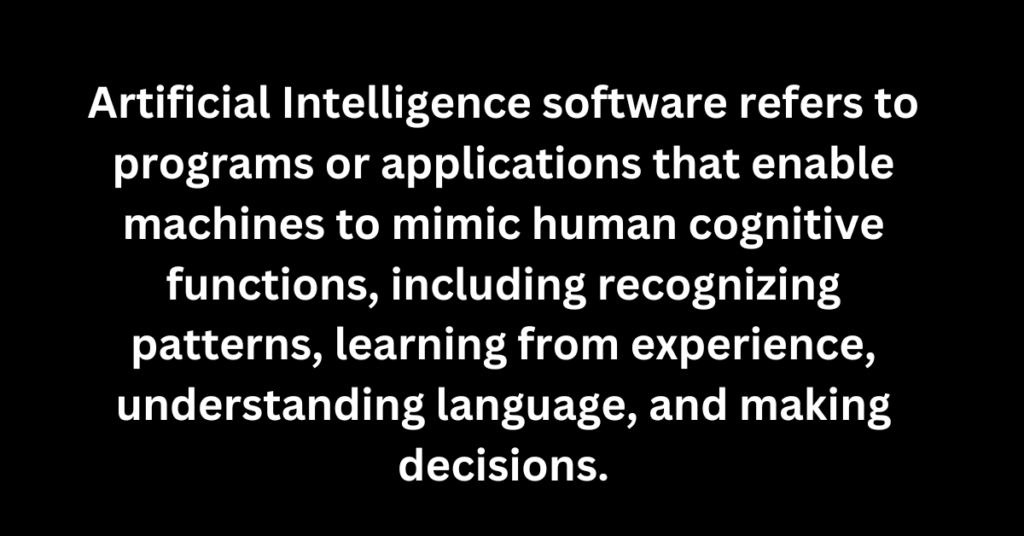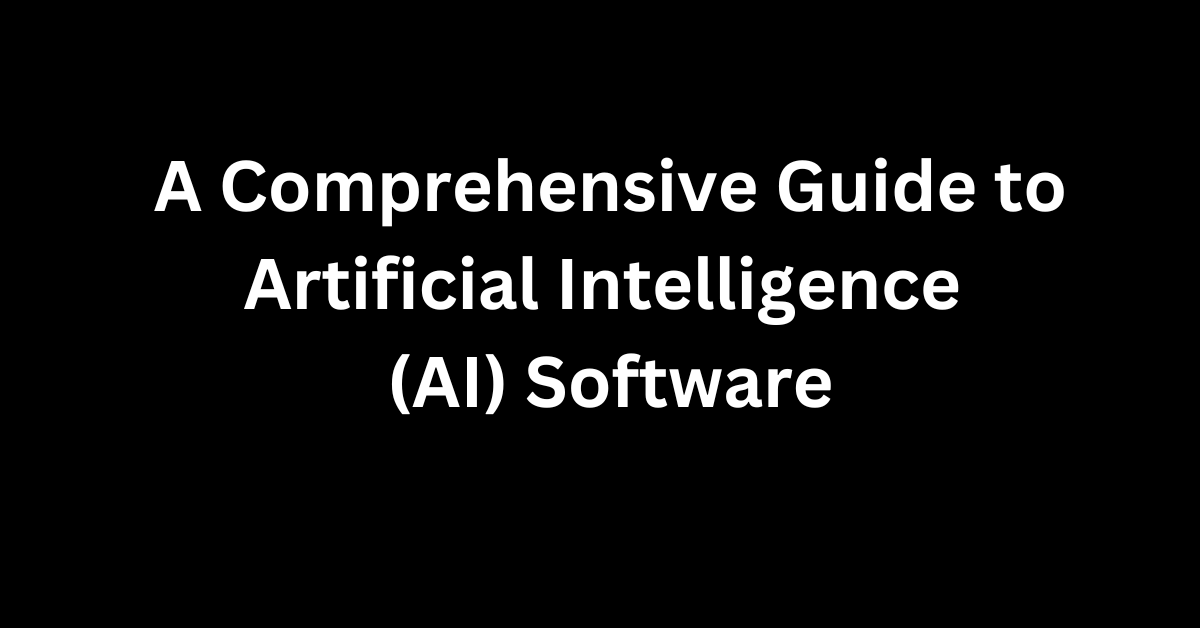Artificial Intelligence (AI) has transitioned from science fiction to a powerful, real-world technology transforming industries and reshaping how businesses operate. AI software refers to computer programs that mimic human intelligence to perform tasks such as reasoning, learning, problem-solving, perception, and language understanding. These systems rely on advanced algorithms, data processing, and machine learning techniques to make decisions and predictions that would traditionally require human intervention.
This comprehensive guide explores the world of AI software, its components, types, applications, benefits, challenges, and future prospects.
What is Artificial Intelligence Software?

Artificial Intelligence software refers to programs or applications that enable machines to mimic human cognitive functions, including recognizing patterns, learning from experience, understanding language, and making decisions. AI software is powered by various subfields of AI, such as:
- Machine Learning (ML): A subset of AI that enables computers to learn from data without being explicitly programmed. Algorithms analyze vast amounts of data to identify patterns, make predictions, or automate decision-making.
- Natural Language Processing (NLP): This AI branch focuses on enabling machines to understand, interpret, and generate human language. NLP powers applications like virtual assistants, chatbots, and sentiment analysis tools.
- Computer Vision: AI-powered systems can interpret and understand visual data from images and videos. This technology is widely used in facial recognition, object detection, and autonomous vehicles.
- Robotics: Robotics incorporates AI to build machines capable of performing complex physical tasks, often autonomously. Industrial robots, drones, and self-driving cars are examples of AI-driven robotics.
AI software typically integrates these components to perform intelligent functions that are valuable in various sectors.
Types of AI Software
Artificial intelligence software comes in different types and categories, depending on its complexity, capability, and purpose. The two major types of AI software are narrow AI (weak AI) and general AI (strong AI).
1. Narrow AI (Weak AI)
Narrow AI is designed and trained to perform specific tasks, such as recognizing speech, identifying objects in images, or playing chess. It is the most prevalent form of AI today and powers applications like virtual personal assistants (e.g., Siri or Alexa), recommendation engines, and customer support chatbots. While narrow AI can outperform humans in its specialized area, it lacks the general cognitive ability to perform tasks outside its defined scope.
Examples of Narrow AI:
- Virtual Assistants: Apple’s Siri, Amazon’s Alexa, and Google Assistant use natural language processing and voice recognition to perform tasks like setting reminders, sending messages, or controlling smart home devices.
- Recommendation Systems: AI-driven recommendation engines, like those used by Netflix, Amazon, or Spotify, analyze user preferences and behaviors to recommend products, movies, or music.
2. General AI (Strong AI)
General AI refers to machines with the ability to perform any intellectual task that a human can do, potentially with the same or higher level of competence. Unlike narrow AI, general AI would have the capacity to understand, learn, and apply knowledge across different domains. General AI is still theoretical and has not yet been achieved, but it remains a goal of long-term AI research.
Examples of Strong AI (Theoretical):
- A fully autonomous robot that can navigate any environment and interact with humans as effectively as a human assistant.
- AI systems capable of self-awareness, consciousness, and general problem-solving across various industries.
How AI Software Works
AI software operates through complex algorithms and models that mimic human cognition. The process involves several core steps, including data collection, data processing, model training, decision-making, and continuous learning.
1. Data Collection and Processing
AI systems require vast amounts of data to function effectively. For example, a facial recognition AI needs a large dataset of labeled images to train its model. The data is collected, processed, and prepped for analysis. Data quality and quantity are critical to the accuracy and performance of AI systems.
2. Model Training and Learning
AI software typically uses machine learning algorithms to learn from the collected data. This involves training the model using supervised learning (with labeled data), unsupervised learning (without labels), or reinforcement learning (learning through feedback from actions). During training, the AI system identifies patterns in the data and adjusts its algorithms to improve accuracy and efficiency.
3. Inference and Decision Making
Once trained, the AI software uses its learned model to make predictions or decisions. In real-time applications, such as virtual assistants or autonomous vehicles, AI systems process new data and respond by generating outputs based on the model’s understanding of the task.
4. Continuous Learning
AI software often incorporates feedback loops to improve over time. As it processes more data or receives corrections from human users, the system can refine its decision-making capabilities, making it more accurate and reliable.
Applications of AI Software Across Industries
AI software has found applications in nearly every industry, from healthcare and finance to manufacturing and retail. Some of the most prominent use cases of AI include:
1. Healthcare
AI is revolutionizing healthcare by improving diagnostics, personalizing treatments, and enhancing patient care. AI software analyzes medical records, scans, and genetic data to identify patterns that aid in diagnosing diseases, predicting patient outcomes, and developing treatment plans.
Applications in Healthcare:
- Medical Imaging: AI-powered imaging tools can detect abnormalities in X-rays, MRIs, and CT scans, helping radiologists identify diseases like cancer, fractures, and neurological conditions.
- Drug Discovery: AI accelerates the drug discovery process by predicting how molecules will interact and identifying promising compounds for development.
- Virtual Health Assistants: AI chatbots and virtual health assistants provide medical advice, schedule appointments, and help patients manage chronic conditions.
2. Finance
The finance industry heavily relies on AI software for fraud detection, algorithmic trading, credit risk assessment, and personalized banking services. AI-driven financial systems can process vast amounts of data in real time, helping organizations make informed decisions and enhance customer experiences.
Applications in Finance:
- Fraud Detection: AI algorithms detect suspicious activities and anomalies in financial transactions, flagging potential fraud in real time.
- Robo-Advisors: AI-powered robo-advisors provide personalized investment advice and portfolio management to individuals based on their financial goals and risk tolerance.
- Algorithmic Trading: AI software analyzes market data, identifies trends, and executes trades at high speed to optimize profit margins for traders and investment firms.
3. Retail and E-commerce
AI software plays a pivotal role in enhancing customer experiences, optimizing supply chains, and personalizing marketing strategies in the retail and e-commerce sectors. From intelligent chatbots to personalized recommendations, AI is reshaping how consumers interact with brands.
Applications in Retail and E-commerce:
- Product Recommendations: AI recommendation engines analyze user behavior and preferences to suggest products that consumers are likely to buy.
- Inventory Management: AI helps retailers optimize stock levels, reducing overstock and understock scenarios through predictive analytics.
- Chatbots: AI-powered chatbots provide customer support, answer frequently asked questions, and assist with product searches and order tracking.
4. Manufacturing
In the manufacturing industry, AI software is being used to streamline production processes, improve quality control, and enhance predictive maintenance. AI systems analyze data from sensors and machinery to identify inefficiencies and potential issues before they occur.
Applications in Manufacturing:
- Predictive Maintenance: AI predicts when equipment is likely to fail, allowing manufacturers to perform maintenance before a breakdown occurs, reducing downtime and repair costs.
- Quality Control: AI-powered image recognition software identifies defects in products during production, ensuring consistent quality.
- Automation: AI software powers industrial robots and automated systems, allowing for faster and more precise production processes.
5. Transportation
AI software is driving innovation in transportation, from self-driving cars to smart traffic management systems. AI-powered systems can analyze real-time traffic data, optimize routes, and enhance vehicle safety, paving the way for autonomous vehicles and intelligent transportation networks.
Applications in Transportation:
- Autonomous Vehicles: AI enables self-driving cars to navigate roads, detect obstacles, and make real-time decisions to ensure safety and efficiency.
- Traffic Management: AI analyzes traffic patterns and congestion to optimize traffic flow and reduce delays.
- Fleet Management: AI software helps logistics companies manage and optimize vehicle fleets, improving delivery times and reducing operational costs.
Benefits of AI Software
The rise of AI software has brought numerous advantages across industries, from improved efficiency and decision-making to enhanced customer experiences and reduced operational costs.
1. Increased Efficiency
AI automates repetitive tasks, freeing up human workers to focus on more complex and strategic activities. This leads to greater efficiency in industries such as manufacturing, logistics, and customer service.
2. Better Decision Making
AI software can analyze vast amounts of data and identify patterns that are often missed by humans. This ability to process and interpret data at high speed enables businesses to make better, data-driven decisions.
3. Cost Reduction
By automating tasks, reducing errors, and optimizing processes, AI can lead to significant cost savings for organizations. For example, predictive maintenance powered by AI reduces downtime and maintenance costs in manufacturing.
4. Personalization
AI software enhances customer experiences by personalizing interactions. Whether through product recommendations, targeted marketing, or customized financial advice, AI tailors services to individual needs and preferences.
5. Scalability
AI software can easily scale across an organization or industry, allowing businesses to handle increasing workloads, customer demands, or data volumes without requiring a proportional increase in human resources.
Challenges of AI Software
Despite its many benefits, AI software comes with several challenges that organizations must address to ensure successful implementation.
1. **Data Privacy and
Security**
AI systems require access to vast amounts of data, raising concerns about data privacy and security. Businesses must ensure that their AI systems comply with data protection regulations such as GDPR and HIPAA.
2. Bias in AI Algorithms
AI systems can sometimes perpetuate bias if they are trained on biased data. Addressing bias in AI models is crucial to ensure fair and equitable outcomes, particularly in areas like hiring, lending, and law enforcement.
3. Lack of Explainability
Many AI models, especially those based on deep learning, operate as “black boxes,” making it difficult to explain their decision-making process. The lack of transparency can be a barrier to trust and adoption in industries where accountability is critical.
4. Skills Gap
Implementing and maintaining AI software requires specialized skills in data science, machine learning, and software engineering. The shortage of qualified AI professionals poses a challenge for organizations looking to adopt AI technologies.
The Future of AI Software
The future of AI software is incredibly promising, with continued advancements in machine learning, natural language processing, and robotics. The development of general AI (AGI) remains a long-term goal, but progress in narrow AI will continue to drive innovation across industries.
Key areas of future AI development include:
- Ethical AI: Ensuring that AI systems operate ethically and without bias is becoming a priority, especially as AI impacts more aspects of daily life.
- AI in Healthcare: AI is expected to revolutionize precision medicine, enabling more accurate diagnoses, personalized treatments, and the development of new therapies.
- AI and Automation: As AI-powered robots and autonomous systems become more sophisticated, industries like manufacturing, logistics, and transportation will continue to experience significant transformation.
In conclusion, AI software is reshaping the way we live, work, and interact with technology. Its ability to automate tasks, analyze data, and make decisions is transforming industries across the globe. While challenges remain, the benefits of AI are undeniable, and its future potential is vast. Organizations that embrace AI software will gain a competitive edge, unlocking new opportunities for growth and innovation.
